Everyone knows the drink, but the actual wormwood herb is relatively unknown. Here you can find out everything about the cultivation, care and harvest of the bitter medicinal herb.

Formerly known as a coveted medicinal plant and today more as a pretty ornamental plant, wormwood (Artemisia absinthium) can hardly be found in the home garden today. On its way back to the beds, we will show you what to consider when planting, caring for and using this diverse plant.
contents
- Wormwood herb: origin and properties
- Wormwood Varieties
- Buy wormwood herb: You have to pay attention to this
-
Planting wormwood: location and procedure
- Wormwood in the bed
- Wormwood in a pot
-
propagate wormwood
- share vermouth
- Propagating wormwood by cuttings
- Propagating wormwood by seed
-
Cultivate wormwood
- Water wormwood
- Fertilize wormwood
- Cut wormwood
- Wormwood herb: crop protection
- Overwinter wormwood
- Harvest Wormwood
- Storing and preserving wormwood herb
- Effect and ingredients of wormwood herb
-
Use of wormwood herb as tea and Co
- Wormwood as a medicinal plant
- Vermouth in alcoholic beverages
- Vermouth in manure and broths
Wormwood herb: origin and properties
Vermouth is best known for its use in the manufacture of absinthe, a liquor essentially made from aniseed (Pimpinella anisum), fennel (Foeniculum vulgare), lemon balm (Melissa officinalis) and wormwood. Botanically heard Artemisia absinthium to the daisy family (asteraceae) and is closely related to mugwort (Artemisia vulgaris) and the Southernwood (Artemisia abrotanum). Wormwood is native to the drier areas of Europe, North Asia and North Africa. The rather inconspicuous plant with the matt green and silvery-grey feathered leaves can reach a height of up to one meter and produces small yellow flowers on panicles from July. In the cold season, the perennial plant is winter green and perennial. Over the years, a clump forms and the wormwood reaches shrub-like proportions. Nowadays, wormwood is mostly found as a domestic ornamental plant in the beds, but it also has valuable properties as a medicinal plant.
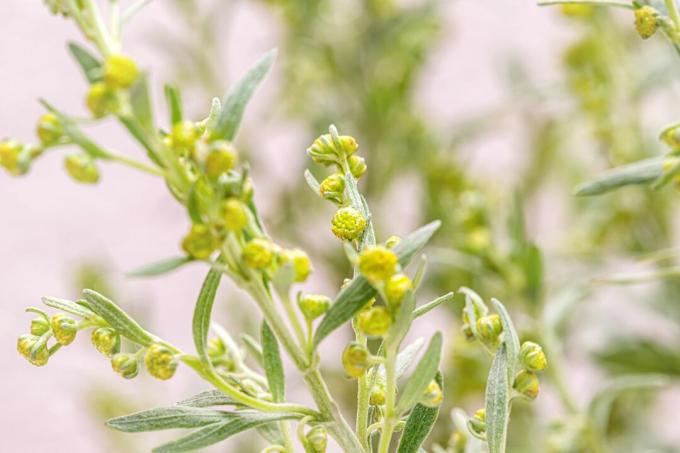
Wormwood Varieties
There are very few varieties of wormwood, as the plant has hardly been cultivated. In the trade, one mainly finds the yellow-flowering true wormwood without further specification of the variety. In recent years, the following two varieties have been selected from wild wormwood.
- ‚Lambrook Silver‘ reaches a height of 100 cm and has white flowers from July to September. The foliage is turquoise green with silver tinges and finely pinnate.
- ‚Lambrook crap‘ grows up to 80 cm high as a compact plant and does not take up as much space over the years. The flowers are silvery-yellow in colour, the foliage finely pinnate.
Buy wormwood herb: You have to pay attention to this
The seed of Artemisia absinthium can be found in most hardware stores and garden centers, it usually also has good germination capacity. The young plants of the true wormwood are also available from spring at relatively low prices in most plant markets. You should pay attention to good root development and flawless, undamaged and, above all, mildew-free silver-grey leaves. The varieties described above can be obtained, for example, from the perennial nursery Gaißmayer, from Stauden Stade or from the perennial nursery Countess of Zeppelin.
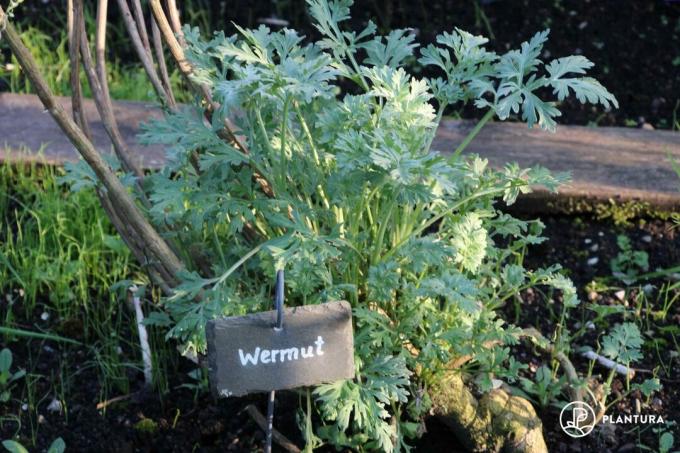
Planting wormwood: location and procedure
Planting the undemanding wormwood is relatively easy. In the following lines you will find out where exactly the medicinal plant feels most comfortable.
Wormwood in the bed
The true wormwood prefers loamy-sandy and tends to be calcareous, well-drained soils in a sunny location. It feels particularly well on nutrient-poor soils such as rock gardens or steppes and can grow into a bushy eyrie. However, wormwood is a loner, so other plants should be kept at a sufficient distance (about 45 cm) as it can stunt their growth. A moderate fertilizer application with organic long-term fertilizer is sufficient for planting. For example, our is suitable for this Plantura organic universal fertilizer fine.
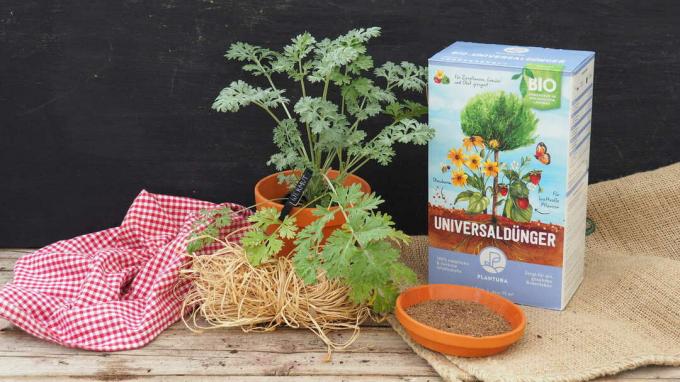
Wormwood in a pot
Vermouth can also be kept individually in a pot. If it is protected from the rain, the risk of mildew infestation is also significantly reduced. As a substrate, nutrient-poor and permeable herb soil is suitable, such as the Plantura Organic Herb & Seed Soil. As a pot culture, however, wormwood should be stored indoors protected from frost in winter, otherwise there is a risk that the substrate will freeze completely and the roots will be damaged.
propagate wormwood
There are several ways to propagate wormwood. In addition to sowing, well-developed plants can also be propagated by dividing the clump or by cuttings. Here we explain exactly how these methods work.
share vermouth
The simplest way of propagation is by dividing the nest in the spring, whereby the existing stock is divided into pieces of any size with a spade and moved directly. Also, when wormwood becomes sluggish, sharing is a good way to rejuvenate it.
Propagating wormwood by cuttings
However, wormwood can also be propagated with cuttings. To do this, cut off the unwoody shoots with a sharp knife in summer and remove the leaves down to the tip. The cuttings are then rooted in a sandy and consistently moist substrate. The high humidity is important here, since cuttings without roots cannot absorb water, but lose it through the leaves. You can create a so-called "tense atmosphere" with high water saturation in the air by covering it with a transparent plastic hood. After a few weeks, the small, rooted clones of the mother plant can migrate outside.
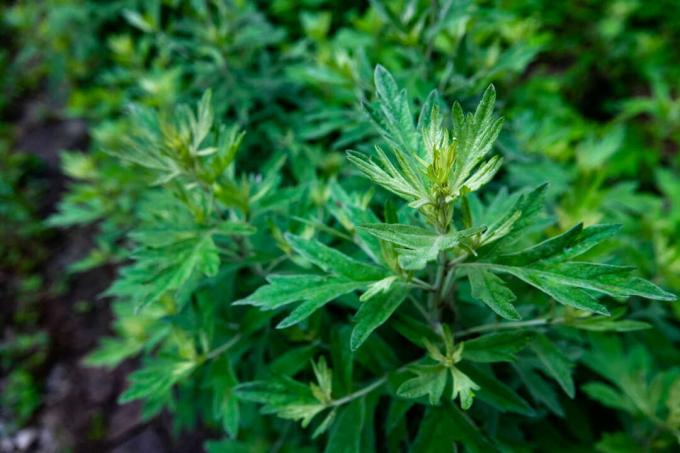
Propagating wormwood by seed
Wormwood can also be sown in bowls from February to July. To do this, you must place the brown, elongated seeds on moistened, nutrient-poor potting soil and press them down so that there is contact with the substrate. The seeds germinate in the light and should therefore not be covered with soil. The cultivation vessels are then placed in a bright place without direct sunlight and kept regularly moist. A transparent plastic cover increases the humidity inside, making it easier for the seeds to germinate. At 10 to 18 °C and after about two to three weeks, germination takes place. From a size of about 5 cm, the plants can be pricked out.
Cultivate wormwood
Overall, the wormwood herb is an undemanding plant, but it also appreciates attention when it comes to care.
Water wormwood
Except in extended periods of drought, wormwood does not have to be watered, as the plant naturally has a low water requirement. Waterlogging and excessive moisture in the substrate should definitely be avoided with this drought-tolerant plant.
Fertilize wormwood
The herb is also extremely frugal when it comes to the nutrient requirement, for planting a compost application is sufficient for the whole year. Regular mulching, such as with lawn clippings or leaves, is sufficient for the wormwood to provide nutrients after the organic matter has decomposed. Alternatively, a small ration of mature compost soil or our primarily organic one will do the trick Plantura organic universal fertilizer in the spring for budding as required. Then simply add 30 to 50 g/m² for additional fertilization2 Work the granules around the surface of the plant and water them lightly.
Cut wormwood
Pruning back in spring or fall encourages shoot renewal, branching and herb rejuvenation. Cutting is also recommended to contain the spread. For use as a medicinal plant, fresh, still unwoody shoots can also be cut continuously. However, you will achieve the highest active ingredient content if you prune the plant to flower.

Wormwood herb: crop protection
Since wormwood contains tannins and bitter substances, it is hardly attacked by diseases or insects. In wet years, powdery mildew occurs, which does not threaten the plant, but reduces its vitality. With biological means - such as a vegetable broth made from horsetail (Equisetum arvense) or baking powder - but you can keep the fungal disease at bay. For the broth, soak 300 g fresh or 30 g dried horsetail in 10 liters of water for 24 hours and then boil for 15 minutes. Diluted in a ratio of 1:5 with water, the cooled broth can be sprayed several times against fungal diseases.
Overwinter wormwood
The medicinal plant is winter green and frost hardy from -20 to -25 °C and can therefore overwinter outdoors. Some mulch or leaves ensure the wormwood survives even in severe temperatures. In the pot, the plant should ideally overwinter in the conservatory or in the house, or alternatively stand well insulated with bubble wrap and plant material and protected from the weather.
Harvest Wormwood
If the wormwood herb has developed enough leaf mass, the plant can be harvested regularly. This is usually the case in the second year after sowing. Harvesting is best done during the flowering period from June to September, as this is when the content of the ingredients is highest. With garden shears you then cut off the leaves and flowers on the stem and lay it out to dry.

Storing and preserving wormwood herb
The dried herb and flowers can be stored in airtight jars for a long time and used as a spice or to make tea. To do this, either tie the cut stalks together loosely and hang them outside, protected from the weather or strip the leaves and flowers from the stems and lay them loosely on a sheet pan or newspaper spread. Gentle drying without direct sunlight best preserves the valuable ingredients.
The fresh herb is preserved for a long time by soaking it in high-proof alcohol (you can find out more about using wormwood herb below). The active ingredients keep for a particularly long time in dark bottles.
Effect and ingredients of wormwood herb
The leaves and flowers of the wormwood herb contain essential oil, which smells very spicy and a little pungent. The smell drives away moths and flies in the house and pests in the garden. However, it also keeps beneficial insects such as earthworms and decomposing microorganisms at a distance. Wormwood should therefore not end up in the compost.
The typical bitter substances in wormwood have a positive effect on digestion, a feeling of fullness and cramps in the stomach and intestines. However, since wormwood contains the neurotoxin thujone in its essential oil, it should not be used long-term. Pregnant women should avoid eating wormwood altogether. The daily dose of 3 g herb in teas or 50 drops of a tincture is considered harmless. Even as a spice in high-fat dishes, the consumption of wormwood is not dangerous, but even promotes the work of the gastrointestinal tract.
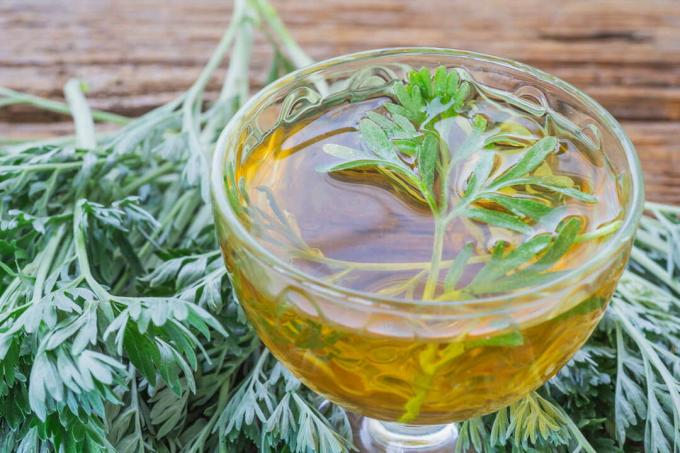
Use of wormwood herb as tea and Co
Wormwood's numerous uses make it an attractive addition to the home garden. In the following we present the various possible uses of the herb.
Wormwood as a medicinal plant
Wormwood has been known as a medicinal plant since ancient times, especially as a herb in alcoholic extracts or as a tea. Hildegard von Bingen described wormwood and its effects in detail and recommended it for all kinds of ailments, both for external and internal use.
The tea, consisting of a teaspoon of wormwood herb in 125 ml of boiling water, has proven its worth to this day for loss of appetite and digestive problems. After 10 minutes steeping time, you can drink a cup a day before or after a meal.
The alcoholic tincture is created by pickling fresh wormwood and flowers in double grain. After four to six weeks, the plant material is filtered out and the tincture is filled into opaque bottles. For digestive problems, it is recommended to take 10 to 50 drops one to three times a day.

Vermouth in alcoholic beverages
Wormwood is also used in the production of schnapps and liqueurs for enjoyment and to promote digestion. For this purpose, the fresh herb is left to stand for up to six weeks with double grain, vodka or other high-proof alcohols. Absinthe and martini are probably the best-known drinks made with wormwood.
Vermouth in manure and broths
Wormwood also has a deterrent effect on many insects and is therefore used in the form of aqueous broths against pests and pathogens. Simply add 300 grams of fresh or 30 grams of dried herb pure or together with tansy (Tanacetum vulgare L.) Ferment in an airtight container with 10 liters of water in a sunny place. Filtered, the broth is sprayed directly against pests such as ants, aphids and caterpillars and is also effective against infestation of columnar rust (Cronartium ribicola) on gooseberries (Ribes uva crispa) and currant bushes (Ribes sp.).
